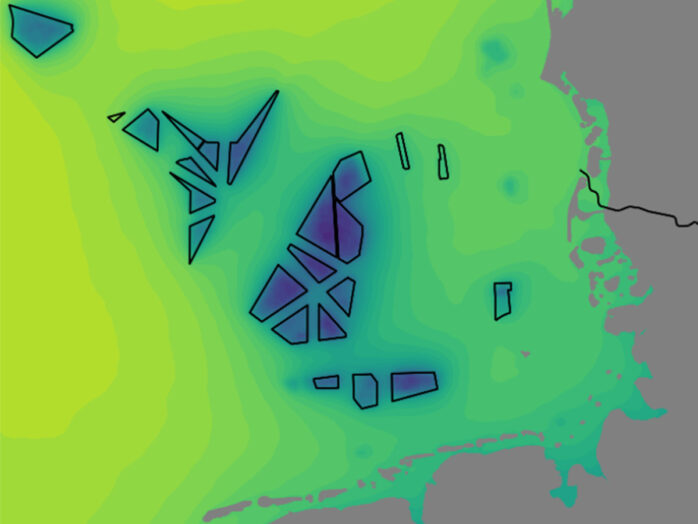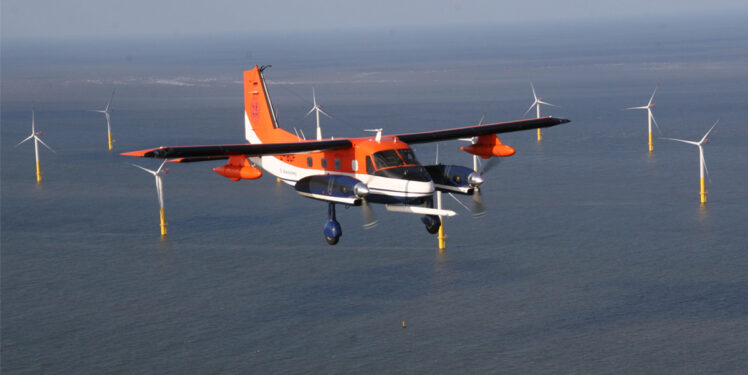Ever since the construction of the first wind farms began in the 1980s, the impact of wind turbines on the flow – the wake effect – has been a major focus not only in the field of wind energy research but also with regard to industrial applications. The wake is referred to as the area downstream of the rotor displaying reduced wind speed due to the extraction of momentum from the flow as well as an increased level of turbulence caused by the mixing of the rotor.
Relevance of wake losses onshore and offshore
For specific wind directions and wind speeds, wake losses in wind farms can approach and even exceed 30% at both onshore and offshore sites. For a typical offshore wind farm, they are typically kept in the range of 10% or lower on an annual energy production level by the optimization of the layout. Thus, wake effects are one of the main factors to be taken into consideration when calculating the future expected yield of a planned wind farm asset. On the one hand, onshore wake losses are typically less pronounced than offshore losses, mainly due to higher ambient turbulence in the inflow and thus mixing of the ambient air and air in the wake that quickly reduces the wind speed deficit downstream of the rotor. On the other hand, the flat surface of the sea leads to a more constant wind speed distribution with height and a considerably less turbulent wind resource at offshore sites. Consequently, offshore wake effects are more persistent and can typically exist over much longer distances.
Recent years have seen the erection of larger and larger wind farms. Modern offshore wind farms can house considerably more than one hundred turbines nowadays. They can be found in several offshore development areas around the globe such as the North Sea in Europe, the US East Coast in North America and the Taiwan Strait in Asia. Multiple offshore wind farms in close proximity to each other define so-called wind farm clusters. These wind farm clusters can contain several gigawatts of installed capacity and thus harvest considerable amounts of energy from the flow and convert it into electrical energy. Onshore, such large wind farm assets can only be found in non-spoilt regions such as the US Great Plains and Northern China.
Since the early days of modern wind turbines, simple models have been used to evaluate the wake losses and calculate the power output of a wind farm. Over the past 40 years, various models have been developed ranging from very simple engineering modeling approaches that account for the wake as simple as a horizontally constant zone of reduced wind speed that could be hat- or Gaussian-shaped to fully turbulence-resolving large-eddy simulations. Due to the high computational costs for larger wind farm simulations, the latter type only be run on modern high-performance computers, yet they remain a very meaningful tool for in-depth scientific wake studies. While wake models on the one hand enable good estimation of the expected yields in the planning phase of wind farms, the wake modeling uncertainty on the other hand is still one of the largest contributors to the overall uncertainty that ultimately often also defines the financing costs. This also explains why research groups all around the globe are working on a better understanding of wake effects as well as improving models of different fidelity levels.
Flow features: Cluster wake and global blockage effects
Large wind farms and wind farm clusters not only extract a great deal of energy from the flow but are also a considerable obstacle that the atmospheric flow has to pass. Two effects that have been the focus of research in recent years are large-scale cluster wake effects and the global blockage effects.
Cluster wake effects can reach as far as 100 km downstream of large wind farms and wind farm clusters as manned aircraft measurements. This is demonstrated within the context of the ‘Wind Park Far Field’ (WIPAFF) research project and the X-Wakes project coordinated by Fraunhofer IWES. These wakes, however, only persist in certain atmospheric conditions, in particular during stably stratified conditions that occur when the sea surface is colder than the air above. In conditions with a warmer sea surface than the overlying air, wakes often vanish within the first kilometers downstream of the asset. It is still difficult to calculate the overall impact over the wind farm’s entire lifetime. Due to the large scales associated with these large wind farms, the evaluation of the wake effects requires models which can resolve domains in the order of several hundreds of kilometers as well as the different atmospheric conditions that a wind farm experiences during its years of operation.
For this purpose, on the one hand, simple top-down approaches exist that calculate the expected impact of large wind farm installations in terms of, e.g., a strongly simplified energy balance. While these models are helpful for studying the sensitivity of different configurations quickly, they are strongly simplified and do not account for the actual wind farm shapes, merely calculating the impact of idealized infinite wind farms on the flow.
On the other hand, wind farm parameterizations have been developed for numerical weather prediction models that are suited for a long time and larger spatial scales. These models have been used in particular over the past ten years for scientific single case studies and validated for single flow conditions, e.g., with the above-mentioned aircraft data. Longer term validations over several months or even years using wind speed measurements or wind farm production data are only available in small quantities and are a current research topic.

Recently, these mesoscale modeling techniques have also been applied in the context of wind farm planning. Figure 1 shows the wind speed at around 100 m, a typical hub height for the German Bight where the impact of future planned wind farms in the German Bight is accounted for. On the one hand, large areas of reduced wind speeds are visible in particular in the center of the large future wind farm clusters. On the other hand, the role for the recovery of the wind field of larger areas not home to wind farms, i.e., shipping routes and nature reserve areas, is visible. The mesoscale wake modeling technique is thus a well-suited tool for evaluating the impact of potential future development plans.
Another important flow feature associated with large-scale wind farm deployment is the global blockage effect. The global blockage describes the cumulative effect of the piling up of the flow due to the blocking by the wind farm. For the single turbine, this effect is typically referred to as induction and extends up to about two to three rotor diameters upstream of the turbine. In the case of larger offshore wind farms and wind farm clusters, numerical studies and also initial measurements revealed larger areas of reduced wind speed upstream of the wind farm. The massive structure blocks the flow in the lower atmosphere here. The magnitude of the global blockage effect depends on the wind farm size, its density layout, and the atmospheric flow conditions. In terms of annual energy production, the global blockage effect typically has an impact of a low one-digit percentage. However, with heavily optimized wind farm assets, even these relatively small numbers can play a significant role nowadays. The currently running “Global Blockage Effect in Offshore Wind” (OWA GlobE) project is an international industry-led initiative that has set-up a large offshore wind campaign to understand and capture the blockage effect in a large offshore wind farm cluster with the aim of providing validation data for the development of more precise as well as fast models for wind farm planning.
Outlook: What needs to be done next?
In conclusion, new questions arise from large-scale wind farm deployments that require new modeling techniques as well as validation data for these models. The increase in computation power and research into new modeling approaches have helped to gain knowledge about these effects in recent years.
However, further research can help to reduce uncertainties even more and thus reduce the cost of electricity through more economic wind farm planning and operation. In the next step, Fraunhofer IWES is therefore actively working on the development of newer modeling techniques and the validation of the same, thus supporting more cost-effective global wind power expansion.
Further information can be found here:
ILES Summer School 2021 (fraunhofer.de)
Application Center for Integration of Local Energy Systems ILES (fraunhofer.de)
Hydrogen Labs (fraunhofer.de)


Daniel says:
Thanks for the information and very useful 🙂
Lisa Bösch says:
Thank you for the feedback Daniel.
Daniel Oxtav says:
Made me know about the effect from wind farm operation
Lisa Bösch says:
Great, thanks for the feedback Daniel!
Distributor Hidrolik says:
Thank You for sharing, visit our web.
https://www.ksj.co.id/